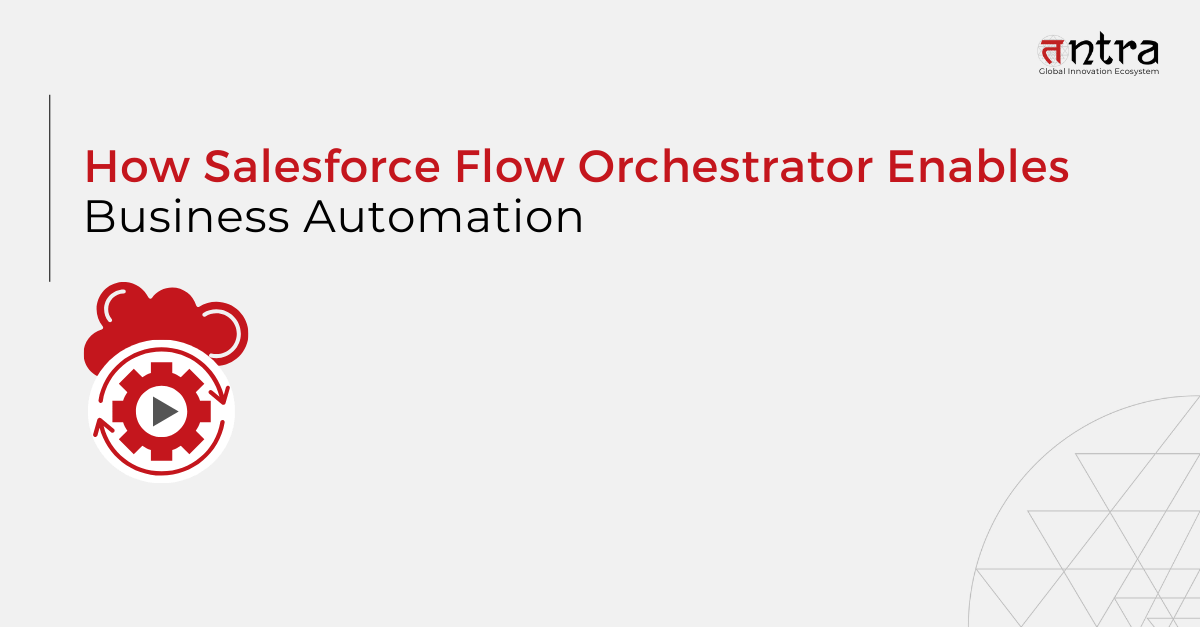
How Salesforce Flow Orchestrator Enables Business Automation
Table of Contents
ToggleSalesforce Flow Orchestrator streamlines complex, multi-step business processes. It organizes numerous flows into stages and steps, enabling smooth communication across teams and systems. Ideal for managing complex approval procedures, conducting data-driven tasks, and interacting with external systems. By automating repetitive activities and ensuring data accuracy, Flow Orchestrator increases efficiency and productivity. It comes with most Salesforce licenses and is a useful tool for organizations looking to optimize operations. Read the blog to learn more about flow orchestration.
Your workflows become increasingly complex as your organization grows. Processes frequently involve input from several people in various departments across multiple time zones. This additional complexity leads to more time spent waiting for each person to finish their work in the correct order. That’s where the Salesforce Flow Orchestrator can help you.
What is Flow Orchestration?
Flow Orchestration allows you to develop orchestrations, which are multi-step processes that interact with various users and systems. An orchestration is a series of stages, each consisting of one or more steps. A stage may contain background, interactive, or MuleSoft steps.
Flow Orchestrator, Salesforce, excels at automating simple Salesforce workflows such as record updates, email sending, and task creation. Salesforce Flow Orchestrator takes the stage when enhanced workflow coordination is required. This includes overseeing sophisticated approval processes, interfacing with external systems, and navigating complex business processes with several steps and decision points.
When Should You Use a Flow Orchestrator?
While Flows are useful for single-object automations, Flow Orchestrator excels at dealing with complicated scenarios in salesforce customization services. Here are some critical circumstances in which business process automation with Flow Orchestrator demonstrates its value:
Multi-Stage Approvals: Manage a multi-level approval process that includes several teams and decision criteria. Route requests based on dynamic criteria to guarantee smooth transitions between approval levels.
Data-Driven Processes: Automate procedures involving data manipulation across numerous objects. Flow Orchestrator enables data interaction between flows, ensuring that information is correct and consistent throughout the process.
User-Friendly processes: Create processes with unambiguous handoffs between phases. This may include soliciting users for input, collecting data, and assigning tasks based on specified conditions.
External System Integrations: Integrate external systems smoothly into your workflow. Flow Orchestrator enables flows to use external APIs and data from other applications.
Types of Salesforce Flow Orchestration
- Auto Launched: Auto launched orchestrations start in reaction to triggers such as Apex, Rest API, and others. They introduce automation seamlessly, responding to external stimuli with quiet efficiency. These orchestrations act as Salesforce automation tools that make automation feel natural and intuitive, triggered not by manual effort but by a touch of code or external signals.
- Record-Triggered Orchestration: When a record is generated or changed, record-triggered orchestrations become the focal point. They respond dynamically to changes in the Salesforce product engineering services ecosystem, ensuring that the cadence of your operations is consistent with record actions. These orchestrations are critical to responsive automation, since they provide a cohesive narrative that complements your business actions.
Benefits of Salesforce Flow Orchestration
Flow Orchestration provides numerous benefits to enterprises that deploy salesforce consulting services. Some of the benefits of flow orchestrator include:
- Time-saving: Flows can automate repeated operations, allowing for significant time savings.
- Enhanced efficiency: Flows ensure that your company procedures are followed consistently, which can increase efficiency.
- Error reduction: Flows for automating error-prone tasks, lowering the likelihood of errors.
- Increased flexibility: Flows can be readily adjusted to match changing needs.
- Improved scalability: Flows can be readily scaled to suit increasing demand.
Flow Orchestrator Use Cases in the Real World
Flow Orchestra is a great asset for firms looking to automate complex processes with interconnected steps and permissions required at several levels. A good Flow Orchestrator Use Case would be an IT company’s Contract Approval and Order Creation procedures. The platform enables smooth cooperation with multiple teams and external vendors in this complex workflow. The need for approvals from multiple managerial positions is handled with precision because flow orchestration enables a systematic and efficient approval workflow.
Managers at various levels are seamlessly linked into the approval chain, creating a robust and compliant approach. Furthermore, the platform excels in job delegation, assigning duties to the organization’s most important individuals or teams. This thorough task assignment guarantees that each stage in the process is carried out by the most skilled staff, hence increasing overall operational efficiency.
Flow orchestration Salesforce solutions serve as the linchpin in the orchestration of Contract Approval and Order Creation, handling the intricacies with ease. Its capacity to expedite interactions, secure necessary clearances, and allocate duties prudently aids in the timely signing of contracts and the development of new orders. Flow orchestrator for approval processes improves operational efficiency and enables organizations to navigate complex operations more accurately by smoothly integrating into the organizational framework.
The Components of Flow Orchestrator
Stages: These are logical phases that group similar steps together, are conducted sequentially, and must meet defined completion conditions.
Steps: A step is where we specify which flow or flows can operate sequentially or concurrently. The system can perform background steps, but the person can complete interactive actions and send notifications.
Flows: Each step follows a flow. Flows can be auto launched or screen flows, which determine the actions and interactions that occur within the orchestration.
Orchestrator Work Guide: Guided User Input
Consider a visual guide that walks users through the input process—this is the Orchestrator Work Guide. A component inserted in record pages using App Builder provides a consistent experience for users entering data and completing tasks.
Cost and Licensing
Flow Orchestrator is included with most Salesforce licenses, including Professional, Enterprise, Unlimited, and Developer Editions. There are no additional licensing expenses for using Flow Orchestrator. However, the regular Salesforce governor constraints on flow execution and storage still apply.
Final Thoughts
Flow Orchestrator automates complex operations in Salesforce, increasing operational efficiency, improving user experiences, and providing deeper insights into your business processes. With its simple UI, extensive learning resources, and diverse use cases, Flow Orchestrator enables you to orchestrate success inside the Salesforce ecosystem. A good Salesforce development company can help to integrate flow orchestration with ease.
Ready to optimize your workflows with Salesforce Flow Orchestrator? Schedule a Call with Salesforce Experts at Tntra, a leading software product engineering company.





